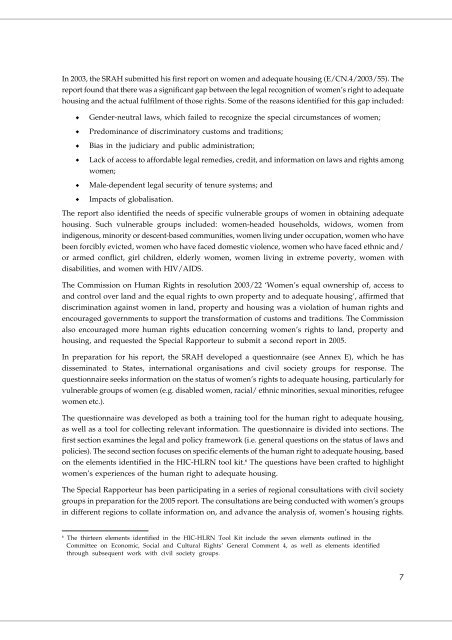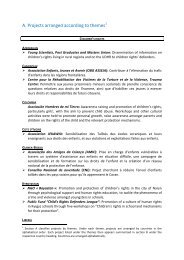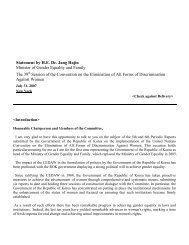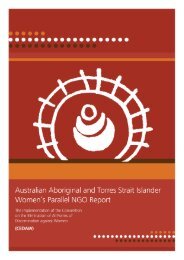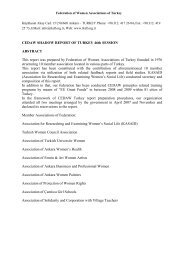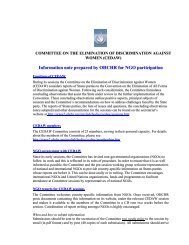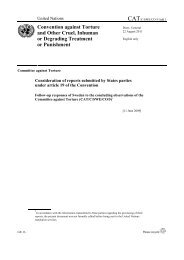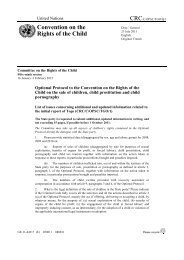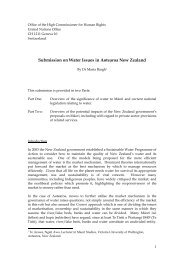Report - Office of the High Commissioner on Human Rights
Report - Office of the High Commissioner on Human Rights
Report - Office of the High Commissioner on Human Rights
- No tags were found...
You also want an ePaper? Increase the reach of your titles
YUMPU automatically turns print PDFs into web optimized ePapers that Google loves.
In 2003, <str<strong>on</strong>g>the</str<strong>on</strong>g> SRAH submitted his first report <strong>on</strong> women and adequate housing (E/CN.4/2003/55). The<br />
report found that <str<strong>on</strong>g>the</str<strong>on</strong>g>re was a significant gap between <str<strong>on</strong>g>the</str<strong>on</strong>g> legal recogniti<strong>on</strong> <str<strong>on</strong>g>of</str<strong>on</strong>g> women’s right to adequate<br />
housing and <str<strong>on</strong>g>the</str<strong>on</strong>g> actual fulfilment <str<strong>on</strong>g>of</str<strong>on</strong>g> those rights. Some <str<strong>on</strong>g>of</str<strong>on</strong>g> <str<strong>on</strong>g>the</str<strong>on</strong>g> reas<strong>on</strong>s identified for this gap included:<br />
<br />
<br />
<br />
<br />
<br />
<br />
Gender-neutral laws, which failed to recognize <str<strong>on</strong>g>the</str<strong>on</strong>g> special circumstances <str<strong>on</strong>g>of</str<strong>on</strong>g> women;<br />
Predominance <str<strong>on</strong>g>of</str<strong>on</strong>g> discriminatory customs and traditi<strong>on</strong>s;<br />
Bias in <str<strong>on</strong>g>the</str<strong>on</strong>g> judiciary and public administrati<strong>on</strong>;<br />
Lack <str<strong>on</strong>g>of</str<strong>on</strong>g> access to affordable legal remedies, credit, and informati<strong>on</strong> <strong>on</strong> laws and rights am<strong>on</strong>g<br />
women;<br />
Male-dependent legal security <str<strong>on</strong>g>of</str<strong>on</strong>g> tenure systems; and<br />
Impacts <str<strong>on</strong>g>of</str<strong>on</strong>g> globalisati<strong>on</strong>.<br />
The report also identified <str<strong>on</strong>g>the</str<strong>on</strong>g> needs <str<strong>on</strong>g>of</str<strong>on</strong>g> specific vulnerable groups <str<strong>on</strong>g>of</str<strong>on</strong>g> women in obtaining adequate<br />
housing. Such vulnerable groups included: women-headed households, widows, women from<br />
indigenous, minority or descent-based communities, women living under occupati<strong>on</strong>, women who have<br />
been forcibly evicted, women who have faced domestic violence, women who have faced ethnic and/<br />
or armed c<strong>on</strong>flict, girl children, elderly women, women living in extreme poverty, women with<br />
disabilities, and women with HIV/AIDS.<br />
The Commissi<strong>on</strong> <strong>on</strong> <strong>Human</strong> <strong>Rights</strong> in resoluti<strong>on</strong> 2003/22 ‘Women’s equal ownership <str<strong>on</strong>g>of</str<strong>on</strong>g>, access to<br />
and c<strong>on</strong>trol over land and <str<strong>on</strong>g>the</str<strong>on</strong>g> equal rights to own property and to adequate housing’, affirmed that<br />
discriminati<strong>on</strong> against women in land, property and housing was a violati<strong>on</strong> <str<strong>on</strong>g>of</str<strong>on</strong>g> human rights and<br />
encouraged governments to support <str<strong>on</strong>g>the</str<strong>on</strong>g> transformati<strong>on</strong> <str<strong>on</strong>g>of</str<strong>on</strong>g> customs and traditi<strong>on</strong>s. The Commissi<strong>on</strong><br />
also encouraged more human rights educati<strong>on</strong> c<strong>on</strong>cerning women’s rights to land, property and<br />
housing, and requested <str<strong>on</strong>g>the</str<strong>on</strong>g> Special Rapporteur to submit a sec<strong>on</strong>d report in 2005.<br />
In preparati<strong>on</strong> for his report, <str<strong>on</strong>g>the</str<strong>on</strong>g> SRAH developed a questi<strong>on</strong>naire (see Annex E), which he has<br />
disseminated to States, internati<strong>on</strong>al organisati<strong>on</strong>s and civil society groups for resp<strong>on</strong>se. The<br />
questi<strong>on</strong>naire seeks informati<strong>on</strong> <strong>on</strong> <str<strong>on</strong>g>the</str<strong>on</strong>g> status <str<strong>on</strong>g>of</str<strong>on</strong>g> women’s rights to adequate housing, particularly for<br />
vulnerable groups <str<strong>on</strong>g>of</str<strong>on</strong>g> women (e.g. disabled women, racial/ ethnic minorities, sexual minorities, refugee<br />
women etc.).<br />
The questi<strong>on</strong>naire was developed as both a training tool for <str<strong>on</strong>g>the</str<strong>on</strong>g> human right to adequate housing,<br />
as well as a tool for collecting relevant informati<strong>on</strong>. The questi<strong>on</strong>naire is divided into secti<strong>on</strong>s. The<br />
first secti<strong>on</strong> examines <str<strong>on</strong>g>the</str<strong>on</strong>g> legal and policy framework (i.e. general questi<strong>on</strong>s <strong>on</strong> <str<strong>on</strong>g>the</str<strong>on</strong>g> status <str<strong>on</strong>g>of</str<strong>on</strong>g> laws and<br />
policies). The sec<strong>on</strong>d secti<strong>on</strong> focuses <strong>on</strong> specific elements <str<strong>on</strong>g>of</str<strong>on</strong>g> <str<strong>on</strong>g>the</str<strong>on</strong>g> human right to adequate housing, based<br />
<strong>on</strong> <str<strong>on</strong>g>the</str<strong>on</strong>g> elements identified in <str<strong>on</strong>g>the</str<strong>on</strong>g> HIC-HLRN tool kit. 6 The questi<strong>on</strong>s have been crafted to highlight<br />
women’s experiences <str<strong>on</strong>g>of</str<strong>on</strong>g> <str<strong>on</strong>g>the</str<strong>on</strong>g> human right to adequate housing.<br />
The Special Rapporteur has been participating in a series <str<strong>on</strong>g>of</str<strong>on</strong>g> regi<strong>on</strong>al c<strong>on</strong>sultati<strong>on</strong>s with civil society<br />
groups in preparati<strong>on</strong> for <str<strong>on</strong>g>the</str<strong>on</strong>g> 2005 report. The c<strong>on</strong>sultati<strong>on</strong>s are being c<strong>on</strong>ducted with women’s groups<br />
in different regi<strong>on</strong>s to collate informati<strong>on</strong> <strong>on</strong>, and advance <str<strong>on</strong>g>the</str<strong>on</strong>g> analysis <str<strong>on</strong>g>of</str<strong>on</strong>g>, women’s housing rights.<br />
6<br />
The thirteen elements identified in <str<strong>on</strong>g>the</str<strong>on</strong>g> HIC-HLRN Tool Kit include <str<strong>on</strong>g>the</str<strong>on</strong>g> seven elements outlined in <str<strong>on</strong>g>the</str<strong>on</strong>g><br />
Committee <strong>on</strong> Ec<strong>on</strong>omic, Social and Cultural <strong>Rights</strong>’ General Comment 4, as well as elements identified<br />
through subsequent work with civil society groups.<br />
EXECUTIVE SUMMARY 7


